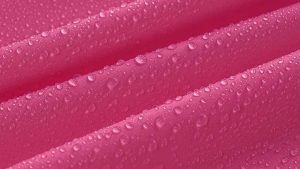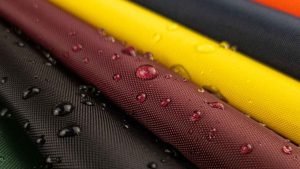10 Tips for Sewing with Waterproof Fabric
2nd August, 2023
Sewing with waterproof materials can be gratifying due to the challenging nature of the fabrics but, as leaders in the Waterproof category in the UK, here are our 10 tips for sewing with waterproof fabric that will help your journey in sewing with these fabrics.
In this blog post, we will help you with these unique fabrics whether you are sewing rainwear, outdoor gear, bags, seat cushions or even gazebos!
What are Waterproof Fabrics?
Waterproof fabrics are textiles that have the incredible ability to repel water and keep you dry, no matter the weather. They are specially designed to protect you and your belongings from moisture in various situations.
The design of waterproof materials holds the key to their effectiveness! These fabric are treated or coated by manufacturers with unique materials that create a strong water barrier.
Waterproofing involves covering a fabric with a layer that prevents water molecules from penetrating while yet enabling air and moisture vapour to escape. This implies that you keep dry without experiencing internal suffocation.
Do you want to know more about Waterproof Fabrics? Read our blog post “What Is Waterproof Fabric?”
10 Tips for Sewing with Waterproof Fabric
Tip 1 – Choose the Right Needle and Thread
When sewing with waterproof fabric, it’s important to select the appropriate needle and thread.
We advise you for a sharp needle designed for heavy-duty fabrics, like a size 90/14 or 100/16. These needles have a sturdier construction that can penetrate the dense fibers of waterproof fabric without breaking.
Pair the needle with a strong polyester or nylon thread that can withstand moisture and provide durable stitching. This combination ensures that your stitches hold up well and maintain the waterproof integrity of the fabric.
For example, when working on a rain jacket made from waterproof fabric, use a size 90/14 needle and a high-quality polyester thread to ensure secure seams.
Tip 2 – Pre-Wash and Dry Your Fabric
Before starting your sewing project, make sure to pre-wash and dry your waterproof fabric, for two reasons:
First, it helps eliminate any sizing or chemicals present in the fabric, ensuring a clean and odor-free final product.
Second, pre-washing allows the fabric to shrink if needed, preventing unexpected shrinkage after you’ve completed your project.
Different fabrics have different requirements but as starting point, 30-degree cycle and if dried in a tumble dryer, do it in the lowest heat setting possible.
Tip 3 – Using Pins
Traditional straight pins may leave unsightly holes or cause the fabric to shift which is undesirable.
Instead of relying heavily on pins, consider using clips or wonder clips to hold your fabric pieces together.
These alternatives provide a secure hold without damaging the fabric or leaving any visible marks. Clips also allow for easier maneuverability and prevent the layers from shifting during the sewing process.
Tip 4 – Seam Sealing
Use seam sealing procedures to keep your seams watertight integrity where water cannot seep through the stitching.
This can be done in a number of ways, such as with waterproof glue, seam sealer, or seam sealing tape.
Depending on the kind of fabric, apply these sealants to the seam allowances or the outside of the seam.
Tip 5 – Test Your Stitches and Tension
Before stitching on your main project, take the time to test your stitches and tension on a fabric scrap.
For example, if you are sewing a waterproof pouch, test the stitches and tension on a scrap of the same fabric to ensure that the machine settings are optimal for the specific fabric type.
Tip 6 – Cutting Tools
We would say this applies to any fabric but waterproof fabric does requires precise cutting.
Invest in quality cutting tools such as sharp fabric scissors or a rotary cutter with a fresh blade. These tools provide clean and accurate cuts, preventing fraying and ensuring straight edges. No one likes fraying, right?
Tip 7 – Seam Allowances
When sewing with waterproof fabric, consider the seam allowances. It’s recommended to use wider seam allowances, around 5/8 inch (1.6 cm), to allow for proper seam sealing and prevent water leakage through the seams.
The wider seam allowance provides enough space for applying seam sealants and ensures that the stitching remains within the waterproof area of the fabric.
Tip 8 – Use a Walking Foot
A walking foot is a valuable tool when sewing with waterproof fabric, especially when sewing items like waterproof tablecloths, make sure to attach a walking foot to your sewing machine to maintain even fabric layers and achieve precise stitching without any fabric shifting.
Using one helps feed the fabric evenly through the machine, preventing layers from shifting, resulting in a smooth and even stitches. Not only that, it reduces the risk of fabric distortion.
Tip 9 – Stay Away from Ironing
Please, please, please, avoid using high heat or direct ironing on waterproof fabric, as it can damage the waterproof coating.
If you need to press your seams, use a low heat setting or a pressing cloth to protect the fabric while achieving the desired results. You could even consider using a pressing tool like a roller to flatten seams without the need for ironing.
Tip 10 – Choose The Right Fabric
The success of your sewing project with waterproof fabric starts with choosing the right fabric for your specific needs so consider the requirements of your project and select the appropriate waterproof fabric accordingly.
For example:
Softshell fabric offers excellent wind and water resistance while providing breathability, making it ideal for outdoor jackets.
Heavy-duty canvas fabric is durable and offers good water repellency, suitable for bags and outdoor gear.
Pul lightweight fabric is specifically designed for diapers and other baby items, providing excellent waterproofing and breathability.
Conclusion
You will be well-equipped to take on your next sewing project with confidence if you stick to our top 10 tips.
Sewing with waterproof fabric can require patience and attention to detail so patience will be needed.
Enjoy the process. Take breaks when needed. Celebrate your accomplishments along the way.
Visit us at UK Fabrics Online to check our Waterproof Fabrics range.
If you have any questions, email us or leave a comment here.
Hope you enjoy this one.
Thank you!


Hi
Thank you for the very helpful article, I do have a question.
It it possible to make your fabric waterproof either before you sew the item or after ? So I mean after the sewing has been done, the complete thing waterproofed, not just the seams sealed ? Or at least water resistant ( easily wiped over.
Another question is, which seam sealants would you recommend ?
Thank you so very much.
Kindest regards
Alison
Hi Alison,
Thanks for the kinds word!
We are the UK’s leading waterproof fabric supplier so no need to think about waterproofing them either before or after. You can just buy waterproof fabrics from us.
https://ukfabricsonline.com/waterproof-fabric
We can definitely help you choose the right waterproof fabric for your application. Would it be easier for you to send us an email to diogo@ukfabricsonline.com?
Regarding seam sealants, we don’t recommend any particular brand. What you have to have in mind is if you need tape or glue.
Seam sealing glue is applied as a liquid and offers flexibility and precision.
Seam sealing adhesive tape is quicker to apply and provides consistent coverage.
You could even use both.
We have written about it too – https://ukfabricsonline.com/blog/the-importance-of-seam-sealing/
Please let us know if you still have any questions!
Best wishes,
UK Fabrics Online.